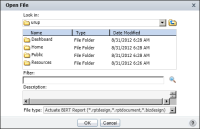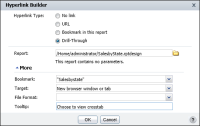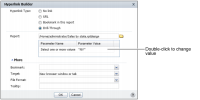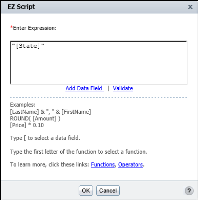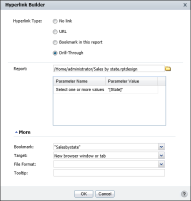How to create a drill‑through hyperlink
1 Select the report column or report element for which you want to create a hyperlink. Then choose Hyperlink from the context menu.
2 Hyperlink Builder appears. On Hyperlink Builder, do the following:
1 In Hyperlink Type, select Drill‑Through.
2 In Report, select the folder icon. Open File appears, as shown in
Figure 9‑9.
Figure 9‑9 Navigating the folder structure to select a target report
3 In Open File, complete the following steps:
1 Navigate through the Encyclopedia volume to select a folder containing the target report.
2 If you know the name of the file you want to specify, type the name, or relevant keywords in Filter. Then, choose Find. Open File displays the reports that match the string you provided.
3 In Description, optionally type a description for the report.
4 In File type, select Actuate BIRT Report if the target report is a BIRT design (.rptdesign) or BIRT document (.rptdocument) file.
Choose OK.
4 In Hyperlink Builder, choose More. Hyperlink Builder displays additional options.
5 In Bookmark, select the bookmark in the target report to which to link. If you do not specify a bookmark, the hyperlink points to the beginning of the target report.
6 In Target, do one of the following:

Select Current browser window or tab.

Select New browser window or tab.
7 In File Format, if necessary, select a format in which to display the target report.
8 In Tooltip, optionally type the text to display when the user hovers the mouse pointer over the hyperlink, as shown in
Figure 9‑10.
Choose OK.
Figure 9‑10 Creating a drill‑through hyperlink to another report
The report design displays the hyperlink based on the options you specified.
You can customize the data displayed in the target report and improve performance by using static filter parameters in the target report. For example, instead of generating a target report that shows sales for all states in a country, use parameters to filter report data by state in the target report. The report displays sales details only for the state that the user specifies in the hyperlink builder dialog box, shown in
Figure 9‑11. Generating a filtered report is typically more efficient than generating a report that displays all the data.
Figure 9‑11 Modifying a parameter value
For the value specified in the example shown in
Figure 9‑11, Actuate BIRT Viewer displays sales details for Nevada, as shown in
Figure 9‑12.
Figure 9‑12 Viewing a target report based
on a parameter value
To set a parameter value based on a data field in the report, you can use the BIRT Studio EasyScript builder to specify the field to use. Complete the following steps:
1 Double‑click the value enclosed in double quotation marks (" "), as shown in
Figure 9‑11. The EasyScript builder appears.
2 On the EasyScript builder, in Enter Expression, type the left bracket ([), and select a data field from the list of fields that appears. Enclose the value in double quotation marks (" "). The example in
Figure 9‑13 shows the selection of the data field, State.
3 Select validate to make sure the syntax for parameter value expression is correct.
4 After a message appears confirming that the expression is valid, as shown in
Figure 9‑13, choose OK.
Figure 9‑13 Expression syntax confirmation message
5 Hyperlink Builder displays the parameter expression you specified, as shown in
Figure 9‑14.
Figure 9‑14 Displaying a parameter expression
6 Run the report to make sure that the data displayed is what you expect.
When a user chooses the hyperlink, the target report uses the specified data field to prompt the user to specify a parameter value to retrieve data to display. For example, to view sales details for Massachusetts, select Massachusetts from the list of values in Parameter. In the target report, make sure that you set a default value for the static filter parameter, if the parameter is required. BIRT Studio does not require you to specify a default value for an optional static filter parameter.
